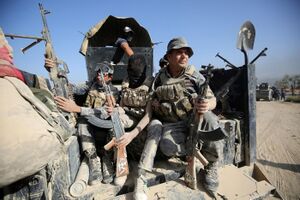Fahel War
| Fahel War | |||||||
|---|---|---|---|---|---|---|---|
| Part of Sarvatian-Zubaydi Conflict | |||||||
 Interior Ministry Troops during the Battle of Dorakhar | |||||||
| |||||||
| Belligerents | |||||||
|
|
| ||||||
| Commanders and leaders | |||||||
|
|
| ||||||
| Units involved | |||||||
|
Units Involved:
| tbd | ||||||
| Strength | |||||||
| 25,000+ | 40,000 | ||||||
| Casualties and losses | |||||||
| 1,217 killed in action | 2,041 killed in action | ||||||
| 572 Civilians killed | |||||||
The Fahel War (Khatti: حرب الفحل; Harb al-Fahl, Sarvati: جنگ فاهل; Jang-e Fahl) also known as the 34-day War and the Operation Guardian of the Toilers was a conflict fought from 13 April 2014 to 17 May 2014 between Zubaydah and Sarvatia. The conflict began as a military incursion by Sarvatia after alleging that Zubaydah was attempting to violently repress ethnic Sarvati protestors in the state of Fahel. The incursions escalated into a full on advance after Zubaydi border security forces failed to fight during the initial stages of the conflict. Troops from the Zubaydi Ministry of Interior were able to fight Sarvatian forces at Dorakhar, Suq al-Zour, and Haram-e Mardak. Zubaydi army forces would organize and arrive, after fighting several battles near the border, the Zubaydi Army was able to push Sarvatian forces back across the border, after a planned and organized retreat from combat.
The conflict reached beyond the Fahel State. Task Force Sawt, a Military Intelligence Directorate unit was sent to the Baloch SSR and made contact with Nahzat-e Azadi. It is reported by Sarvatia (denied by Zubaydah) that the Sawt Task Force was sent to engineer the May Incidents, which included several coordinated attacks against Military Bases, Police Stations, and Party Headquarters in the city of Mandar. This was followed by NA militants taking control of the SSR's Supreme Soviet. There were similar incidents in the Khatt SSR involving Rabitat al-Mujahidin wal-Muahidin which conducted several attacks on important infrastructure. Most notably their attacks along Freeway 9 which served as an important logistics route for invading forces.
The conflict was claimed as a victory for both sides. Zubaydah was able to fight Sarvatian forces off of its territory before a formal end to the conflict, while Sarvatia saw the invasion as a success as it put pressure on Zubaydi political forces to deal with the Faheli Sarvatis more cautiously. The conflict also served to help secure Premier Amanullah Azd al-Uqayli’s position within the government. His introduction of the Zubaydi Interior Troops was seen as a success and effectively gave al-Uqayli a personal paramilitary, with their success in the conflict cementing their position within the government structure. The Conflict came to an end on 17 May after a formal ceasefire was declared, later that July the two sides would sign the Kalaghamut Agreement, which set out provisions for further conflicts at the border to be settled diplomatically and set out new border policies for both side, although no agreements on territorial changes were made.